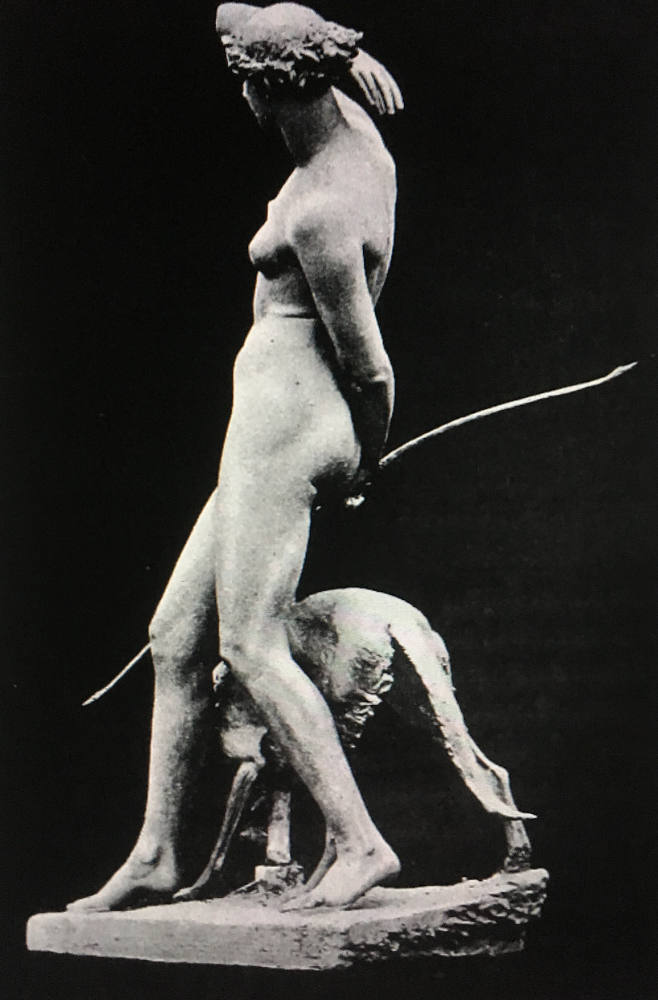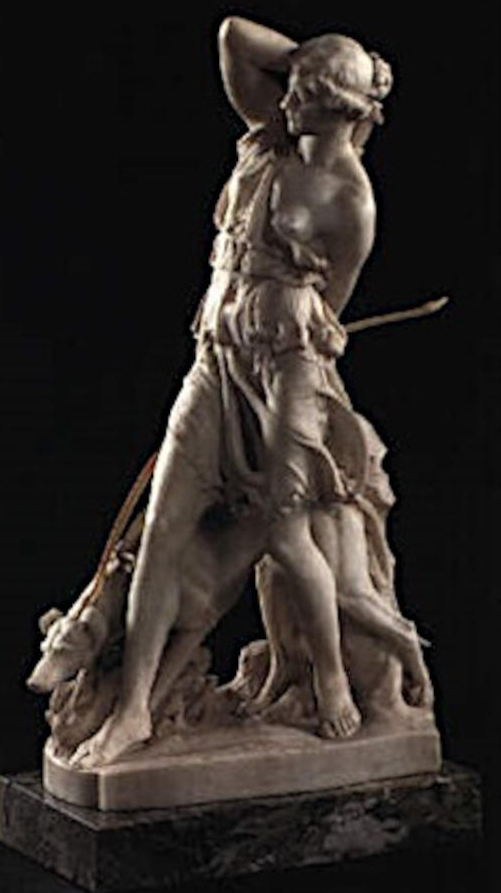

Artemis. Sir W. Hamo Thornycroft, R. A. (1850-1925). Left: Bronze statuette, dark brown patination. 25 inches (63.5 cm) high, inscribed on base “ARTEMIS” and signed “HAMO THORNYCROFT/SC; Hamo Thornycroft 1909.” Private collection. Right: Artemis (before drapery), reproduced from a photograph in The Art Journal 56 (1894): 141. [Click on these images to enlarge them.]

he sculpture of Artemis (Artemis and her Hound) was first modelled in 1879. Thornycroft first worked on a half-size model from April-June and then began a full-size clay model on September 24, 1879. He began draping the figure in January 1880 and had completed the plaster model by March 31, 1880.
While still adhering to the classical tradition in this work Thornycroft gave it a lively freshness that was new in England at that date (Manning 79). Thornycroft's model for Artemis was an Italian woman named Antonia Paria, the wife of a local ice-cream seller. The model for the greyhound was a stray that Thornycroft had taken in and named Diana. The plaster version of the work was completed in 1880 and was exhibited first at the Paris Salon and then at the Royal Academy in London. It is now at Macclesfield Town Hall having been presented by Lady Thornycroft in 1926. The critic Edmund Gosse greatly praised Artemis to the architect Alfred Waterhouse, who was then designing Eaton Hall for the Duke of Westminster. The Duke subsequently commissioned a life-size marble version of it. Between its completion and installation at Eaton Hall in Cheshire, the sculpture was exhibited at the Paris Salon and Royal Academy exhibtion of 1882.


Left: Full-size plaster version. 1880. Macclesfield Town Hall, Cheshire. Right: Detail of bronze statuette showing drapery.”
Spielman had these comments on the original plaster:
A great advance was proclaimed the following year [1880] by the epoch-making ‘Artemis.’ It came as a surprise even to those who, as they thought, had fairly gauged the sculptor’s commanding power. With feet unsandalled – for a goddess need not fear the thorns – the great huntress pauses suddenly in the forest as a quarry passes near; and as she snatches at an arrow in her quiver her body is drawn around by her dog, which has darted to the other side. The attitude and arrangement are altogether admirable, as well as original; and the triply caught-up chiton is a charming invention. From every point of view the group is beautiful; the forms and the head are nobly conceived, and the dog is a brilliant piece of animal life sculpturesquely treated…When this statue was exhibited it aroused the greatest enthusiasm; and while many were comparing it with the late Greek ‘Artemis’ in the Louvre, which had presumably inspired it, they were loudly proclaiming the superiority of the modern English work…It may be added that, beautiful as is the figure in its graceful, light, diaphanous drapery, the life-size model, entirely nude, leaves the spectator in doubt whether it is not in this stage more lovely than its final form” (39).
The critic of The Saturday Review subsequently thought the marble sculpture of 1882 was even an improvement over the earlier version: “Since the ‘Artemis’ was exhibited in plaster in 1880, we find the artist the artist has considerably improved it; the legs seem more robust, the drapery in some details more free and natural, and the neck more finely modelled”(731).
A half-size bronze version of Artemis was exhibited at the Royal Academy in 1911 [no. 1799] and another bronze statuette at the Royal Scottish Academy in 1917-18. Bronze statuettes of Artemis very occasionally appear on the market. A half-size marble version sold at Sotheby’s, London on May 12, 1995. This may be the unfinished version that once belonged to Lady Thornycroft that was included in the Exhibition of Decorative Art, the winter exhibition of the Royal Academy in 1923 (no. 128).
Bibliography
Manning, Elfrida. Marble and Bronze. The Art and Life of Hamo Thornycroft. London: Trefoil Books, 1982.
Spielmann, Marion H. British Sculpture and Sculptors of Today. London: Cassell and Co. Ltd., 1901.
“Sculpture in 1882.” The Saturday Review. 53 (1882): 731-32.
Sotheby’s, London: 19th & 20th Century Sculpture, May 12, 1995, lot 179, Artemis, 33 in. (83.8 cm), signed and dated 1910, white marble on an ivory green marble base.
You may use these images without prior permission for any schol(1) credit the photographer and (2) link your document to this URL in a web document or cite the Victorian Web in a print one.]
Last modified 17 April 2021